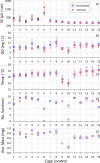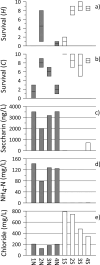Insights into In Situ Benthic Caging Tests for Ecotoxicity Assessments Targeting Discharging Groundwater Contaminant Plumes
- PMID: 38961028
- PMCID: PMC11283422
- DOI: 10.1007/s00244-024-01075-9
Insights into In Situ Benthic Caging Tests for Ecotoxicity Assessments Targeting Discharging Groundwater Contaminant Plumes
Abstract
While in situ toxicity testing with caged organisms has been used to assess surface water and sediment contamination, no successful application to benthic organisms exposed to highly contaminated groundwater plumes discharging to surface waters has been reported. The objective of this study was to demonstrate and evaluate this application using four sets of tests performed at three previously reported contaminated groundwater sites, which include one river site affected by volatile organic contaminant plumes, and two sites, one pond and one small urban stream, impacted by landfill plumes. The study examined multiple cage designs and orientations and two test organisms: an amphipod (Hyalella azteca) and midge larvae (Chironomus riparius; only one study). Cages were deployed for between 5 and 28 days and assessed for organism survival and growth. At all sites and for some deployment conditions, cages exposed to high contaminant concentrations in the plume footprint had greater mortality compared to those exposed to lower or background concentrations. Organism growth was less clear as a metric of toxicity. Vertically oriented cages typically showed high mortality to plume contaminants, but some were also affected by other non-target groundwater conditions (e.g., low dissolved oxygen, other contaminant sources), while horizontally oriented cages were rarely responsive to either groundwater influence. A hybrid cage design showed much promise in its single study. Useful observations on the test organisms and on potentially problematic site conditions were also made. The informed use of in situ toxicity cages could be an additional beneficial tool for groundwater contaminated site assessments.
© 2024. Crown.
Conflict of interest statement
The authors have no relevant financial or non-financial interests to disclose.
Figures






Similar articles
-
Laboratory toxicity and benthic invertebrate field colonization of Upper Columbia River sediments: finding adverse effects using multiple lines of evidence.Arch Environ Contam Toxicol. 2012 Jul;63(1):54-68. doi: 10.1007/s00244-012-9752-9. Epub 2012 Mar 9. Arch Environ Contam Toxicol. 2012. PMID: 22402778
-
Multizone Aquatic Ecological Exposures to Landfill Contaminants from a Groundwater Plume Discharging to a Pond.Environ Toxicol Chem. 2023 Aug;42(8):1667-1684. doi: 10.1002/etc.5650. Epub 2023 Jun 14. Environ Toxicol Chem. 2023. PMID: 37194992
-
Relative sensitivity of an amphipod Hyalella azteca, a midge Chironomus dilutus, and a unionid mussel Lampsilis siliquoidea to a toxic sediment.Environ Toxicol Chem. 2015 May;34(5):1134-44. doi: 10.1002/etc.2909. Epub 2015 Apr 7. Environ Toxicol Chem. 2015. PMID: 25655578
-
Laboratory and Field-Based Assessment of the Effects of Sediment Capping Materials on Zinc Flux, Bioavailability, and Toxicity.Environ Toxicol Chem. 2020 Jan;39(1):240-249. doi: 10.1002/etc.4612. Epub 2019 Nov 27. Environ Toxicol Chem. 2020. PMID: 31610605
-
Sources, pathways, and relative risks of contaminants in surface water and groundwater: a perspective prepared for the Walkerton inquiry.J Toxicol Environ Health A. 2002 Jan 11;65(1):1-142. doi: 10.1080/152873902753338572. J Toxicol Environ Health A. 2002. PMID: 11809004 Review.
References
-
- Burton GA, Chapman PM, Smith EP (2002) Weight-of-evidence approaches for assessing ecosystem impairment. Hum Ecol Risk Assess Int J 8(7):1657–1673. 10.1080/2002809105754710.1080/20028091057547 - DOI
-
- Burton GA, Greenberg MS, Rowland CD, Irvine CA, Lavoie DR, Brooker JA, Moore L, Raymer DFN, McWilliam RA (2005) In situ exposures using caged organisms: a multi-compartment approach to detect aquatic toxicity and bioaccumulation. Environ Pollut 134(1):133–144. 10.1016/j.envpol.2004.07.008 10.1016/j.envpol.2004.07.008 - DOI - PubMed
-
- Burton GA, Rosen G, Chadwick DB, Greenberg MS, Taulbee WK, Lotufo GR, Reible DD (2012) A sediment ecotoxicity assessment platform for in situ measures of chemistry, bioaccumulation and toxicity. Part 1: system description and proof of concept. Environ Pollut 162:449–456. 10.1016/j.envpol.2011.11.018 10.1016/j.envpol.2011.11.018 - DOI - PubMed
-
- Canadian Council of Ministers of the Environment (CCME) (2023) https://ccme.ca/en/summary-table. Accessed May 1, 2023.
MeSH terms
Substances
LinkOut - more resources
Full Text Sources

